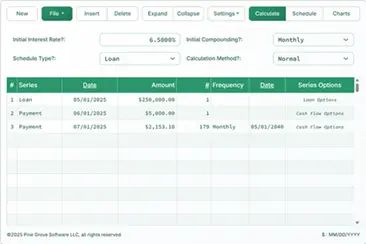How to Calculate a U.S. Rule Loan
To set your preferred currency and date format, click the “$ : MM/DD/YYYY” link located in the lower right corner of any calculator.
A Step-by-Step Tutorial
Tutorial 16
The U.S. Rule is defined in the United States Consumer Financial Protection Bureau’s (formerly the Federal Reserve’s) Regulation Z. This regulation is also known as the Truth in Lending Act:
3. U.S. Rule. The U.S. Rule produces no compounding of interest in that any unpaid accrued interest is accumulated separately and is not added to principal. In addition, under the U.S. Rule, no interest calculation is made until a payment is received.
Under the U.S. Rule, only the unpaid principal balance (excluding unpaid interest) is used as the basis for calculating interest due.
If there are no periods of negative amortization, then amortization under the U.S. Rule is the same as standard amortization.
Negative amortization occurs when the loan balance increases despite regular payments being made. This happens when a payment is less than the interest due.
The Ultimate Financial Calculator supports all of these rules and behaviors.
All users should first review the more detailed first tutorial to understand the basic concepts and settings of the UFC.
To create an amortization schedule that uses the U.S. Rule and tracks unpaid interest separately, follow these steps:
- Set Schedule Type to Loan.
- Alternatively, click the button to remove any previous entries.
- Click , then select . Set Rounding to Adjust last amount to reach “0” balance.
- In the header section, make the following selections:
- For Calculation Method, select U.S. Rule.
- Set Initial Compounding to Monthly.
- Enter 6.0 as the value for Initial Interest Rate.
- In row 1 of the cash-flow input area, create a Loan series.
- Set the Date to July 1, 2024.
- Set the Amount to $35,000.00.
- Set the # Periods to 1.
- Note: When the number of periods is set to 1, you cannot specify a frequency. If a frequency is entered, it will be cleared automatically when you leave the row.
- Move to row 2 of the cash-flow input area.
- Select Payment for the Series.
- This example assumes a 5-year loan with 60 monthly payments.
- The first six payments will be $150.00. This is less than the interest due for each period.
- Set the Date to August 1, 2024.
- Set the Amount to $150.00.
- Set the # Periods to 6.
- Select Payment for the Series.
- Move to row 3 of the cash-flow input area.
- Select Payment for the Series.
- Set the Date to February 1, 2025.
- Set the Amount to Unknown by typing U.
- Set the # Periods to 54.
- Your calculator will now look like this (Fig. 1):

- Click . The calculated result is $744.35. See Fig. 2.

- To view how the U.S. Rule affects the loan, display the amortization schedule:
- Click . See Fig. 3.

(This is referred to as negative amortization when the loan balance increases even though payments are being made.)
- Points to note about the schedule:
- The loan experiences negative amortization—the balance increases because the first six payments are less than the interest due.
- The unpaid interest is recorded as a separate balance, as required by the U.S. Rule.
- Although the loan balance grows, the interest amount due each month remains constant at $175.00.
- You may want to compare this schedule to another one that uses the same inputs but sets the Calculation Method to Normal.
The U.S. Rule is considered consumer-friendly because it reduces the amount of interest that would otherwise accumulate. However, it only affects interest calculations when negative amortization occurs. Even then, the difference is often small. You can use the Ultimate Financial Calculator to compare both methods and view the results.
Back to the Ultimate Financial Calculator.
